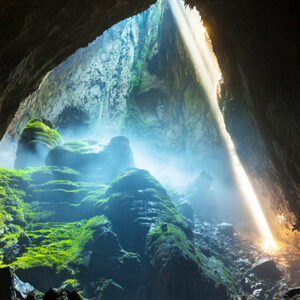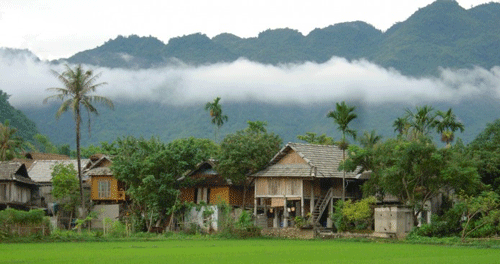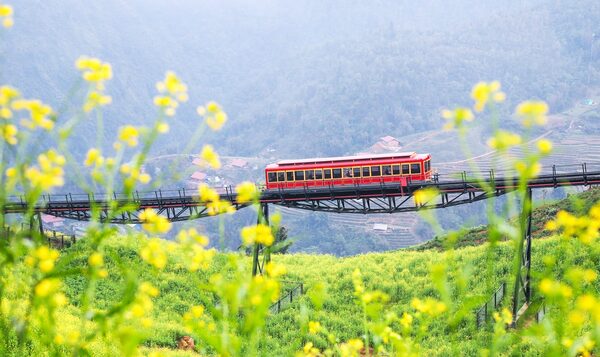Quang Binh is best known for its caves, but this province has much more to offer.
Vietnam travel, why Visit Quang Binh? Nestled in the heart of Vietnam, Quang Binh province is a true treasure of breathtaking natural landscapes and invaluable cultural riches. Listed as a UNESCO World Heritage Site, the region is famous for its spectacular caves, crystal-clear rivers, and pristine beaches.
Forfaits touristiques recommandés :- Historical DMZ tour and Paradise Cave 2 days 1 night
- Across Vietnam Tour for Family 15 Days
- KONG: SKULL ISLAND – Touring Kong’s trail throughout Vietnam!
Whether you are an adventure enthusiast, a nature lover, or seeking relaxation, Quang Binh offers a variety of captivating activities and stunning panoramas. Embark on an unforgettable journey and discover why Quang Binh is a must-visit destination in Vietnam.
Overview of Quang Binh
Quang Binh is a province located on the central coast of Vietnam, where the natural and cultural elements of the North and South regions meet. Experienced travelers to Quang Binh describe it as a land blessed by nature. Although Quang Binh’s area is not very large, it offers a diversity of landscapes, including forests, beaches, mountains, rivers, and plains.
Quang Binh is situated in the biodiversity region of the Northern Truong Son mountains, with rich and unique flora and fauna, harboring many rare genes. The province boasts a vast maritime expanse, beautiful beaches, and abundant marine life, including rare species such as lobsters, tiger shrimp, and sea cucumbers.
In 2024, Quang Binh was hailed by the renowned travel magazine Travel+Leisure as a beautiful region of Vietnam, where visitors can explore countless caves, rivers, and streams. The towering mountains, lush and diverse vegetation make Quang Binh a true paradise, promising an ideal retreat in untouched and peaceful nature.
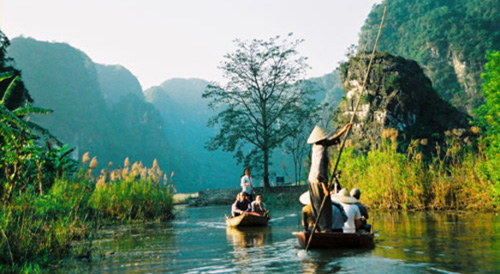
Why visit Quang Binh?
Quang Binh, nicknamed the kingdom of caves, is also distinguished by the Phong Nha – Ke Bang National Park, a UNESCO World Heritage Site. By traversing winding roads and legendary rivers, visitors will discover giant and mysterious caves hidden in the pristine forest, amidst majestic and untouched nature.
The inhabitants of Quang Binh are known for their friendliness and hospitality. With the favorable combination of nature, environment, and people, Quang Binh has become a prominent destination on the Vietnamese tourism map.
Why Visit Quang Binh
1. Explore the “Kingdom of Caves”
Quang Binh is renowned as the “kingdom of caves” with more than 350 caves of all sizes, among the most beautiful in the world (according to Touropia). Among these, Son Doong Cave, the largest cave in the world, and the Phong Nha – Ke Bang National Park, a UNESCO World Heritage Site, stand out. These giant, mysterious, and majestic caves hidden in the virgin forest are must-visit destinations for adventure and exploration enthusiasts.
2. Wild and Imposing Nature
Besides the world-famous caves, Quang Binh is one of the most ideal places to explore famous natural wonders in Vietnam. The province offers a variety of breathtaking natural attractions, from towering mountain ranges and virgin forests to long; the coast is dotted with blue water, yellow sand beaches that sparkle. Visitors can relax on Nhat Le Beach, swim in the crystal-clear waters of the Chay River, or explore the virgin forest of Phong Nha – Ke Bang National Park. Quang Binh is also a filming location for many movies requiring majestic natural landscapes.
3. Unique Culture and Gastronomy
Visitors will discover the distinctive culture of Quang Binh through traditional festivals such as the Le Thuy boat race festival, the Dong Hoi Culture and Tourism Week, and the Phong Nha – Ke Bang Cave Festival. The delectable cuisine is also a highlight with specialties like “chao canh ca loc” (snakehead fish rice soup), eel vermicelli soup, and “banh beo” (water fern cake), offering unforgettable culinary experiences.
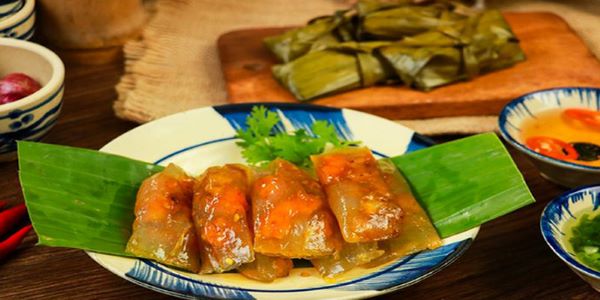
Banh bot loc Quang Binh
4. Warm and Welcoming Inhabitants
Why visit Quang Binh? The inhabitants of Quang Binh are renowned for their friendliness and hospitality. Visitors will feel the warmth and strong connection the locals have with nature, making their journey even more special.
5. Easy Travel
Quang Binh boasts a well-developed transportation network, allowing visitors to easily reach the province by road, train, or plane. Dong Hoi Airport connects Quang Binh to major national and international cities, facilitating travel planning.
6. History and Cultural Heritage
Quang Binh is home to numerous valuable cultural and historical heritages, from war relics to traditional craft villages. Visitors can explore the Dong Hoi Citadel, an important historical site, and discover local life and culture through craft villages producing conical hats and weaving traditional fabrics.
7. Outdoor Activities and Adventure Sports
Why visit Quang Binh? Quang Binh offers numerous exciting outdoor activities and adventure sports, from hiking to kayaking and rock climbing. Visitors can also participate in entertaining and cave exploration tours, experience thrilling adventures, and admire unique natural wonders.
Quang Binh offers unique experiences such as paragliding over Nhat Le Beach, fishing on the Gianh River, or joining rural tourism tours to discover the life of local residents. These activities will provide visitors with unforgettable memories.
Notably, the “Explore the Lim Forest – Kong’s Home” tour on all-terrain vehicles (ATVs) operates in Tan Hoa Commune, Minh Hoa District. This is the location chosen by director Jordan Vogt-Roberts for the filming of the Hollywood blockbuster “Kong: Skull Island” in 2016. During this 2-hour tour, visitors control their own path, drive through the forest, conquer every turn and hill, cross streams, and navigate through dark tunnels.
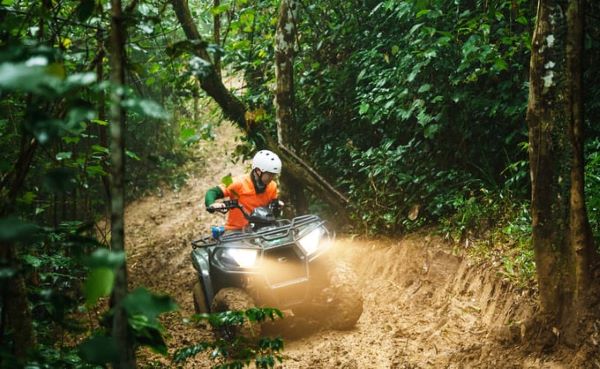
“Explore the Lim Forest – Kong’s Home” tour
8. Conservation and Sustainable Tourism
Quang Binh emphasizes nature conservation and the development of sustainable tourism. Tourist activities are designed to protect the environment and respect local culture. This attracts travelers who are concerned about sustainable development and eager to have responsible tourism experiences.
9. Relaxation and Leisure
Quang Binh offers numerous seaside resorts and luxury hotels where visitors can relax and enjoy high-end services. The beachfront resorts provide ideal spaces for rest and rejuvenation.
10. Easy Connection to Other Destinations
Why visit Quang Binh? Quang Binh is ideally located, allowing easy connections to other famous destinations in central Vietnam, such as Hue, Da Nang, and Hoi An. Visitors can plan an itinerary to explore the central region with many attractive stops.
Travel Tips for Quang Binh
Best Time to Visit Quang Binh
Quang Binh’s climate is tropical with two distinct seasons: the dry season from April to August and the rainy season from September to March. Although the dry season can be sunny, most areas of the province remain cool thanks to the presence of the sea and rivers.
April and May are the ideal months to visit Quang Binh because the weather is dry without being too hot. If you wish to enjoy the beaches and rivers, you can go in June and July. Additionally, you can participate in local festivals such as:
- The Le Thuy boat racing festival, held annually on September 2.
- Dong Hoi Culture and Tourism Week and the traditional boat racing and tram fishing contest on the Son River, held from April 30 to May 1.
- The Minh Hoa full moon festival in the lunar March.
- The Phong Nha – Ke Bang cave festival from July 20 to August 20.
The end of the year, particularly from September to November, is the typhoon season, so it is not advisable to travel to Quang Binh during this period.
Must-See Sites in Quang Binh
Phong Nha – Ke Bang National Park
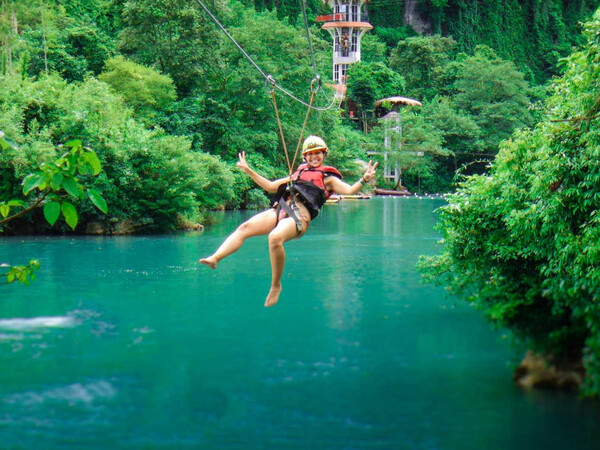
Phong Nha – Ke Bang is renowned for offering some of the most exhilarating ziplining experiences in Asia.
Phong Nha – Ke Bang National Park, a UNESCO World Heritage site, is renowned for its over 400 caves extending over 220 km and its three main rivers: Chay, Son, and Trooc. Located about 50 km from Dong Hoi in the Bo Trach and Minh Hoa districts, the park offers various points of interest.
The park’s botanical garden allows visitors to discover endemic plant and animal species, showcasing threatened and rare species. Visitors can explore the garden, admire the Gio waterfall, and visit the wildlife care centers.
Additionally, there are many attractions to visit in this national park. Tien Son Cave, also known as the “dry cave,” is famous for its impressive system of stalactites and stalagmites. Approximately 980 meters long, it offers a complete exploration without the need for swimming or boating. Its unique combination of natural light and shimmering formations makes it a must-see attraction.
Formed millions of years ago by the erosion of limestone mountains, Phong Nha Cave is a natural wonder recognized for its aesthetic and geological beauty. According to explorers, it is distinguished by its impressive underground river, large entrances, underwater beaches and rocks, splendid underground lake, vast dry cave, spectacular stalactite system, and exceptional length as an aquatic cave.
Read More: Top 8 Activities in Phong Nha – Ke Bang National Park in Vietnam
Chay River, originating from the limestone mountains, meets the Toi Cave, known for its ancient stalactite formations. This river is the starting point for various adventure activities, such as zip-lining over the river, kayaking, swimming in the Thuy Tien Lake inside Toi Cave, and mud baths.
Son River, also known as Son Source, Rao Son, or Trooc River, flows entirely within Quang Binh province. Its source, over 7,700 meters long, passes through limestone mountains. It originates at the exit of Phong Nha Cave and joins the Gianh River at Ba Don. Visitors can participate in boat tours to discover the picturesque landscapes and majestic mountains along the Son and Gianh Rivers.
Paradise Cave
Nicknamed the “underground palace,” Paradise Cave is located about 70 km northwest of downtown Dong Hoi, near the western branch of the Ho Chi Minh Road, approximately 25 km from Phong Nha Cave.
Visitors must climb over 500 steps to reach the cave entrance. Inside, they discover a vast space adorned with numerous stalactites and stalagmites. With its 31.4 km length, Paradise Cave is considered the longest dry cave in Asia.
Son Doong Cave
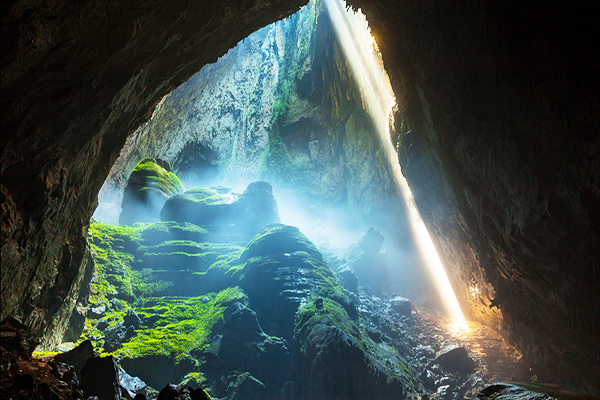
Son Doong Cave, the most dangerous cave in Vietnam and the longest cave in the world
Son Doong Cave is currently the largest natural cave in the world, formed approximately 2 to 5 million years ago. It measures 150 meters wide, over 200 meters high, and nearly 9 kilometers long, with an estimated volume of 38.5 million cubic meters. The stalagmite columns in the cave reach up to 14 meters in height.
Inside, there is a 2.5-kilometer-long underground river, coral reefs, and fossil remnants. The cave also features two “paths of light,” where sunlight penetrates and allows the growth of a tropical forest, with one area called the “Garden of Edam.”
To explore Son Doong Cave, visitors must book a tour, prepare their physical condition, and learn about safety rules. Tours are available from late January to August each year, with a 5-day and 4-night itinerary, each tour limited to an average of 10 people.
Read More: Explore World’s Largest Cave – Son Doong: Vietnam travel attraction
En Cave
En Cave is the third largest cave in the world, spanning 1.6 kilometers through a massive limestone mountain. It has three entrances, the largest and most famous of which measures 120 meters high and 110 meters wide, with a ceiling reaching 145 meters and the widest corridor being 200 meters. Inside, a winding river leads to Son Doong Cave. The Hollywood film “Peter Pan” was filmed here.
Tours to explore En Cave are available from December to the end of September each year. The adventure lasts two days, featuring trekking activities such as forest traversal, river crossing, hill climbing, and exploration of Doong Village, home to the Bru – Van Kieu people.
Beaches
Bao Ninh Peninsula
Located east of Dong Hoi City, Bao Ninh Peninsula is peaceful, bordered by the sea on one side and the Nhat Le River on the other. Visitors come here not only for a Vietnam beach holiday but also to participate in various sports activities such as volleyball, kite flying, and surfing. Bao Ninh is distinguished by its pristine coastline and remarkable cultural sites such as ancient fortifications, the temple dedicated to Ca Ong, Truong Sa Fort, Sa Chu Post, and the Mother Suot Monument, a notable figure from the Vietnam War.
Da Nhay Beach (Jumping Rocks Beach)
Located in Bo Trach District, about 26 kilometers north of Dong Hoi, Da Nhay Beach is a remarkable site along National Route 1A. The coastal rocks here have been eroded and worn over time, creating unique natural shapes such as rocks resembling a rooster and hen, elephant, and tiger seemingly jumping the waves. Visitors can engage in various recreational activities like kayaking, climbing, and coastal dune walks.
Mooc Stream
Mooc Stream, located in Bo Trach District and about 70 kilometers from Dong Hoi City, lies along the western branch of the Ho Chi Minh Road. Nestled in a valley surrounded by limestone mountains and near the Chay River, Mooc Stream is distinguished by its deep blue waters year-round, especially during hot summer days.
Visitors can participate in various recreational and exploratory activities such as swimming races, kayaking, fishing, and zip-lining. For these activities, it is necessary to purchase an entrance ticket as well as tickets for each game.
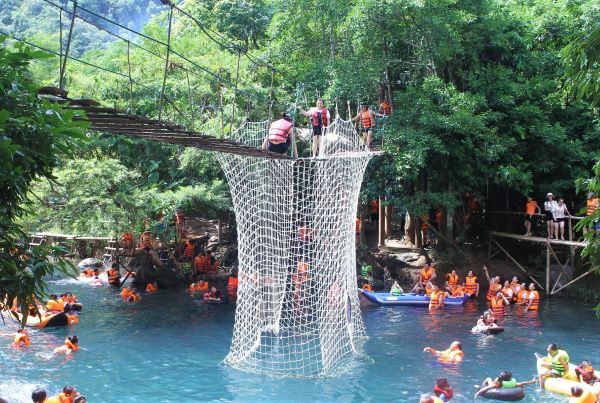
Tourists have fun at the Mooc stream
Why Visit Quang Binh? Quang Binh is more than just a travel destination; it’s a place where nature and history converge to offer unique and unforgettable experiences. From majestic caves to serene rivers, golden beaches, and fascinating historical sites, every corner of this Vietnamese province has something extraordinary to offer.
Whether you are an adventurer seeking thrills, a lover of breathtaking landscapes, or simply looking for a beautiful escape from the daily hustle and bustle, Quang Binh promises a full immersion into the raw beauty and cultural richness of Vietnam. Don’t wait any longer to discover this hidden gem and let yourself be enchanted by the magic of Quang Binh during your Central Vietnam tour, a destination that will captivate and inspire at every moment.

